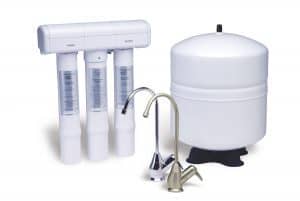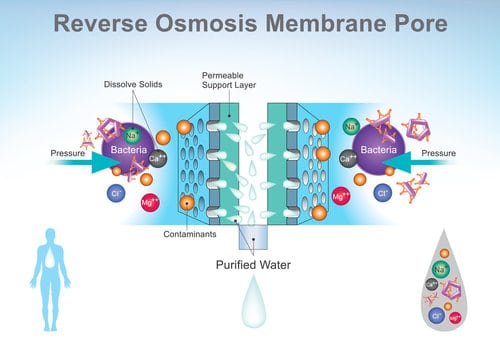 Reverse Osmosis Purification
Have you ever wondered what Reverse Osmosis is or how it works? We have captured some excerpts from an article on science.howstuffworks.com by Kate Kershner. Kate explains it well with a little humor built in. We thought you might find it interesting.
“Water issues have become an extremely pressing global threat. With climate change come unprecedented environmental impacts: torrential flooding in some areas, droughts in others, rising and falling sea levels. Add to that the threat of overpopulation — and the demand and pollution a swelling population brings — and water becomes one of the paramount environmental issues to watch for in the next generation.
Water treatment plants and systems are now adapting reverse osmosis to address some of these concerns. What we really need to understand is how the heck the process occurs. Assuming that you have a fairly good grasp on the definition of “reverse,” we better start by taking a look at how osmosis works before we put the two together.
Osmosis is the passage or diffusion of water or other solvents through a semipermeable membrane that blocks the passage of dissolved solutes [source: Encyclopedia Britannica].
What, you don’t get it? No fear. Most of us don’t, which is why there are countless explanations and analogies to clarify osmosis. We’ll explore a few of those, but first let’s break osmosis down to its parts to get a grasp on it.
First, we’ll make our solution. We start with a boring old cup of water. To spice things up, we’ll call water the “solvent” — which is convenient, because that’s what it is. To make our solvent a little tastier, we’ll dissolve in some delicious sugar. The sugar is the solute. Just to keep track, we now have water (solvent) that we’ve dissolved sugar (solute) in, to make sugar water (our solution).
Now that we have our solution of sugar water, we’ll grab a U-tube. This is not an internet video of kittens and monkeys hugging; a U-tube is a beaker, shaped in a u-shape. Right in the middle of the tube, imagine a bit of Gore-tex that cuts the U in half. Gore-tex is our “semipermeable membrane.” Gore-tex is a thin plastic, dotted with a billion tiny little holes that allow water vapor to pass through, but liquid to stay out. (Saran wrap wouldn’t let anything through, and a piece of cotton fabric would let just about anything.)
In one arm of the U-tube, we pour our sugar water mixture. On another we pour our plain old water. That’s when the magic of osmosis begins, if you find the movement of water magical. The level of liquid in the sugar water arm will slowly rise, as the solvent (water) moves through the Gore-tex, to make both sides of the arm more equal in a sugar-to-water ratio.
But why does that happen? Simply put, because water wants to find equilibrium. And because the one side of the arm is crowded with sugar, pure water from the other side decides to move on over to make the concentration more equal or until the osmotic pressure (the pressure that happens as the molecules move) is reached.
So there you are; osmosis is when a solvent of low concentrated solute solution moves through a membrane to get to the higher concentrated solution, thus weakening it. You did it!
So we learned that in osmosis, a lower-concentrate solution will filter its solvent to the higher concentrate solution. In reverse osmosis, we are (literally) just reversing the process, by making our solvent filter out of our high concentrate into the lower concentrate solution. So instead of creating a more equal balance of solvent and solute in both solutions, it is separating out solute from solvent.
But as we’ve explored, that isn’t something that solutions really want to do. How do we make reverse osmosis occur? We put the solution under pressure. Let’s take saltwater as an example:
In reverse osmosis, we’d have ourselves a saltwater solution on one side of a tank and pure water on the other side, separated by a semi-permeable membrane. We would apply pressure to the saltwater side of the tank–enough to counteract the natural osmotic pressure from the pure water side, and then to push the saltwater through the filter. (This takes about 50-60 bars of pressure [source: Lenntech. But because of the size of the salt molecules, only the smaller water molecules would make it to the other side, thus adding fresh water to the water side, and leaving the salt on the other.
And voila, you’ve seen reverse osmosis. So, reverse osmosis takes place when pressure applied to a highly concentrated solute solution causes the solvent to pass through a membrane to the lower concentrated solution, leaving a higher concentration of solute on one side, and only solvent on the other.
Reverse osmosis is also one of the few ways that we can take certain minerals or chemicals out of a water supply. Reverse osmosis can filter out impurities on a large scale in a way that a charcoal based filter (like the one most commonly found in homes) can’t.”
If you are interested in a Reverse Osmosis Drinking Water System in your home, we can help. Contact us at 952-392-4449 in the South Metro or 612-294-8599 in central MN.
Your water. Our solution
Reverse Osmosis Purification
Have you ever wondered what Reverse Osmosis is or how it works? We have captured some excerpts from an article on science.howstuffworks.com by Kate Kershner. Kate explains it well with a little humor built in. We thought you might find it interesting.
“Water issues have become an extremely pressing global threat. With climate change come unprecedented environmental impacts: torrential flooding in some areas, droughts in others, rising and falling sea levels. Add to that the threat of overpopulation — and the demand and pollution a swelling population brings — and water becomes one of the paramount environmental issues to watch for in the next generation.
Water treatment plants and systems are now adapting reverse osmosis to address some of these concerns. What we really need to understand is how the heck the process occurs. Assuming that you have a fairly good grasp on the definition of “reverse,” we better start by taking a look at how osmosis works before we put the two together.
Osmosis is the passage or diffusion of water or other solvents through a semipermeable membrane that blocks the passage of dissolved solutes [source: Encyclopedia Britannica].
What, you don’t get it? No fear. Most of us don’t, which is why there are countless explanations and analogies to clarify osmosis. We’ll explore a few of those, but first let’s break osmosis down to its parts to get a grasp on it.
First, we’ll make our solution. We start with a boring old cup of water. To spice things up, we’ll call water the “solvent” — which is convenient, because that’s what it is. To make our solvent a little tastier, we’ll dissolve in some delicious sugar. The sugar is the solute. Just to keep track, we now have water (solvent) that we’ve dissolved sugar (solute) in, to make sugar water (our solution).
Now that we have our solution of sugar water, we’ll grab a U-tube. This is not an internet video of kittens and monkeys hugging; a U-tube is a beaker, shaped in a u-shape. Right in the middle of the tube, imagine a bit of Gore-tex that cuts the U in half. Gore-tex is our “semipermeable membrane.” Gore-tex is a thin plastic, dotted with a billion tiny little holes that allow water vapor to pass through, but liquid to stay out. (Saran wrap wouldn’t let anything through, and a piece of cotton fabric would let just about anything.)
In one arm of the U-tube, we pour our sugar water mixture. On another we pour our plain old water. That’s when the magic of osmosis begins, if you find the movement of water magical. The level of liquid in the sugar water arm will slowly rise, as the solvent (water) moves through the Gore-tex, to make both sides of the arm more equal in a sugar-to-water ratio.
But why does that happen? Simply put, because water wants to find equilibrium. And because the one side of the arm is crowded with sugar, pure water from the other side decides to move on over to make the concentration more equal or until the osmotic pressure (the pressure that happens as the molecules move) is reached.
So there you are; osmosis is when a solvent of low concentrated solute solution moves through a membrane to get to the higher concentrated solution, thus weakening it. You did it!
So we learned that in osmosis, a lower-concentrate solution will filter its solvent to the higher concentrate solution. In reverse osmosis, we are (literally) just reversing the process, by making our solvent filter out of our high concentrate into the lower concentrate solution. So instead of creating a more equal balance of solvent and solute in both solutions, it is separating out solute from solvent.
But as we’ve explored, that isn’t something that solutions really want to do. How do we make reverse osmosis occur? We put the solution under pressure. Let’s take saltwater as an example:
In reverse osmosis, we’d have ourselves a saltwater solution on one side of a tank and pure water on the other side, separated by a semi-permeable membrane. We would apply pressure to the saltwater side of the tank–enough to counteract the natural osmotic pressure from the pure water side, and then to push the saltwater through the filter. (This takes about 50-60 bars of pressure [source: Lenntech. But because of the size of the salt molecules, only the smaller water molecules would make it to the other side, thus adding fresh water to the water side, and leaving the salt on the other.
And voila, you’ve seen reverse osmosis. So, reverse osmosis takes place when pressure applied to a highly concentrated solute solution causes the solvent to pass through a membrane to the lower concentrated solution, leaving a higher concentration of solute on one side, and only solvent on the other.
Reverse osmosis is also one of the few ways that we can take certain minerals or chemicals out of a water supply. Reverse osmosis can filter out impurities on a large scale in a way that a charcoal based filter (like the one most commonly found in homes) can’t.”
If you are interested in a Reverse Osmosis Drinking Water System in your home, we can help. Contact us at 952-392-4449 in the South Metro or 612-294-8599 in central MN.
Your water. Our solution  Reverse Osmosis Purification
Have you ever wondered what Reverse Osmosis is or how it works? We have captured some excerpts from an article on science.howstuffworks.com by Kate Kershner. Kate explains it well with a little humor built in. We thought you might find it interesting.
“Water issues have become an extremely pressing global threat. With climate change come unprecedented environmental impacts: torrential flooding in some areas, droughts in others, rising and falling sea levels. Add to that the threat of overpopulation — and the demand and pollution a swelling population brings — and water becomes one of the paramount environmental issues to watch for in the next generation.
Water treatment plants and systems are now adapting reverse osmosis to address some of these concerns. What we really need to understand is how the heck the process occurs. Assuming that you have a fairly good grasp on the definition of “reverse,” we better start by taking a look at how osmosis works before we put the two together.
Osmosis is the passage or diffusion of water or other solvents through a semipermeable membrane that blocks the passage of dissolved solutes [source: Encyclopedia Britannica].
What, you don’t get it? No fear. Most of us don’t, which is why there are countless explanations and analogies to clarify osmosis. We’ll explore a few of those, but first let’s break osmosis down to its parts to get a grasp on it.
First, we’ll make our solution. We start with a boring old cup of water. To spice things up, we’ll call water the “solvent” — which is convenient, because that’s what it is. To make our solvent a little tastier, we’ll dissolve in some delicious sugar. The sugar is the solute. Just to keep track, we now have water (solvent) that we’ve dissolved sugar (solute) in, to make sugar water (our solution).
Now that we have our solution of sugar water, we’ll grab a U-tube. This is not an internet video of kittens and monkeys hugging; a U-tube is a beaker, shaped in a u-shape. Right in the middle of the tube, imagine a bit of Gore-tex that cuts the U in half. Gore-tex is our “semipermeable membrane.” Gore-tex is a thin plastic, dotted with a billion tiny little holes that allow water vapor to pass through, but liquid to stay out. (Saran wrap wouldn’t let anything through, and a piece of cotton fabric would let just about anything.)
In one arm of the U-tube, we pour our sugar water mixture. On another we pour our plain old water. That’s when the magic of osmosis begins, if you find the movement of water magical. The level of liquid in the sugar water arm will slowly rise, as the solvent (water) moves through the Gore-tex, to make both sides of the arm more equal in a sugar-to-water ratio.
But why does that happen? Simply put, because water wants to find equilibrium. And because the one side of the arm is crowded with sugar, pure water from the other side decides to move on over to make the concentration more equal or until the osmotic pressure (the pressure that happens as the molecules move) is reached.
So there you are; osmosis is when a solvent of low concentrated solute solution moves through a membrane to get to the higher concentrated solution, thus weakening it. You did it!
So we learned that in osmosis, a lower-concentrate solution will filter its solvent to the higher concentrate solution. In reverse osmosis, we are (literally) just reversing the process, by making our solvent filter out of our high concentrate into the lower concentrate solution. So instead of creating a more equal balance of solvent and solute in both solutions, it is separating out solute from solvent.
But as we’ve explored, that isn’t something that solutions really want to do. How do we make reverse osmosis occur? We put the solution under pressure. Let’s take saltwater as an example:
In reverse osmosis, we’d have ourselves a saltwater solution on one side of a tank and pure water on the other side, separated by a semi-permeable membrane. We would apply pressure to the saltwater side of the tank–enough to counteract the natural osmotic pressure from the pure water side, and then to push the saltwater through the filter. (This takes about 50-60 bars of pressure [source: Lenntech. But because of the size of the salt molecules, only the smaller water molecules would make it to the other side, thus adding fresh water to the water side, and leaving the salt on the other.
And voila, you’ve seen reverse osmosis. So, reverse osmosis takes place when pressure applied to a highly concentrated solute solution causes the solvent to pass through a membrane to the lower concentrated solution, leaving a higher concentration of solute on one side, and only solvent on the other.
Reverse osmosis is also one of the few ways that we can take certain minerals or chemicals out of a water supply. Reverse osmosis can filter out impurities on a large scale in a way that a charcoal based filter (like the one most commonly found in homes) can’t.”
If you are interested in a Reverse Osmosis Drinking Water System in your home, we can help. Contact us at 952-392-4449 in the South Metro or 612-294-8599 in central MN.
Your water. Our solution
Reverse Osmosis Purification
Have you ever wondered what Reverse Osmosis is or how it works? We have captured some excerpts from an article on science.howstuffworks.com by Kate Kershner. Kate explains it well with a little humor built in. We thought you might find it interesting.
“Water issues have become an extremely pressing global threat. With climate change come unprecedented environmental impacts: torrential flooding in some areas, droughts in others, rising and falling sea levels. Add to that the threat of overpopulation — and the demand and pollution a swelling population brings — and water becomes one of the paramount environmental issues to watch for in the next generation.
Water treatment plants and systems are now adapting reverse osmosis to address some of these concerns. What we really need to understand is how the heck the process occurs. Assuming that you have a fairly good grasp on the definition of “reverse,” we better start by taking a look at how osmosis works before we put the two together.
Osmosis is the passage or diffusion of water or other solvents through a semipermeable membrane that blocks the passage of dissolved solutes [source: Encyclopedia Britannica].
What, you don’t get it? No fear. Most of us don’t, which is why there are countless explanations and analogies to clarify osmosis. We’ll explore a few of those, but first let’s break osmosis down to its parts to get a grasp on it.
First, we’ll make our solution. We start with a boring old cup of water. To spice things up, we’ll call water the “solvent” — which is convenient, because that’s what it is. To make our solvent a little tastier, we’ll dissolve in some delicious sugar. The sugar is the solute. Just to keep track, we now have water (solvent) that we’ve dissolved sugar (solute) in, to make sugar water (our solution).
Now that we have our solution of sugar water, we’ll grab a U-tube. This is not an internet video of kittens and monkeys hugging; a U-tube is a beaker, shaped in a u-shape. Right in the middle of the tube, imagine a bit of Gore-tex that cuts the U in half. Gore-tex is our “semipermeable membrane.” Gore-tex is a thin plastic, dotted with a billion tiny little holes that allow water vapor to pass through, but liquid to stay out. (Saran wrap wouldn’t let anything through, and a piece of cotton fabric would let just about anything.)
In one arm of the U-tube, we pour our sugar water mixture. On another we pour our plain old water. That’s when the magic of osmosis begins, if you find the movement of water magical. The level of liquid in the sugar water arm will slowly rise, as the solvent (water) moves through the Gore-tex, to make both sides of the arm more equal in a sugar-to-water ratio.
But why does that happen? Simply put, because water wants to find equilibrium. And because the one side of the arm is crowded with sugar, pure water from the other side decides to move on over to make the concentration more equal or until the osmotic pressure (the pressure that happens as the molecules move) is reached.
So there you are; osmosis is when a solvent of low concentrated solute solution moves through a membrane to get to the higher concentrated solution, thus weakening it. You did it!
So we learned that in osmosis, a lower-concentrate solution will filter its solvent to the higher concentrate solution. In reverse osmosis, we are (literally) just reversing the process, by making our solvent filter out of our high concentrate into the lower concentrate solution. So instead of creating a more equal balance of solvent and solute in both solutions, it is separating out solute from solvent.
But as we’ve explored, that isn’t something that solutions really want to do. How do we make reverse osmosis occur? We put the solution under pressure. Let’s take saltwater as an example:
In reverse osmosis, we’d have ourselves a saltwater solution on one side of a tank and pure water on the other side, separated by a semi-permeable membrane. We would apply pressure to the saltwater side of the tank–enough to counteract the natural osmotic pressure from the pure water side, and then to push the saltwater through the filter. (This takes about 50-60 bars of pressure [source: Lenntech. But because of the size of the salt molecules, only the smaller water molecules would make it to the other side, thus adding fresh water to the water side, and leaving the salt on the other.
And voila, you’ve seen reverse osmosis. So, reverse osmosis takes place when pressure applied to a highly concentrated solute solution causes the solvent to pass through a membrane to the lower concentrated solution, leaving a higher concentration of solute on one side, and only solvent on the other.
Reverse osmosis is also one of the few ways that we can take certain minerals or chemicals out of a water supply. Reverse osmosis can filter out impurities on a large scale in a way that a charcoal based filter (like the one most commonly found in homes) can’t.”
If you are interested in a Reverse Osmosis Drinking Water System in your home, we can help. Contact us at 952-392-4449 in the South Metro or 612-294-8599 in central MN.
Your water. Our solution 


